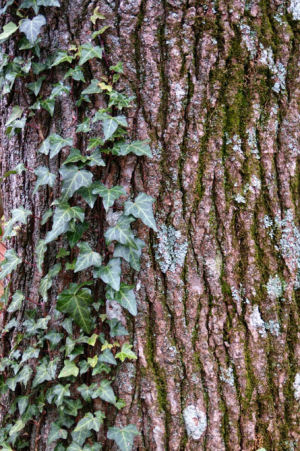Ivy nanoparticles promise sunblocks and other green products
Its natural nanoparticles exhibit unusual functions and are more biodegradable than the metal oxides they could replace
I’ve developed a love-hate relationship with English ivy that’s been devolving towards hate-hate. In my yard and neighboring ones, this invasive creeper sends fast-growing vines snaking through grasses, fencing and shrubs, then up trees, brick walls and light posts. But a new paper may temper my antipathy. It indicates that this backyard bully also offers a kinder, gentler alternative to the potentially toxic metal-based nanoparticles used in today’s sunscreens.


Once it colonizes a site, ivy hangs on with impressive resolve. Trying to wrench free even dead vines that have glommed onto some surface can take tremendous brute strength. While working in Silicon Valley, several years ago, bionanotechnologist Mingjun Zhang began puzzling over that holding power. His backyard wall was covered with ivy, and he wanted to know how its vines managed to climb so effectively and maintain such a dogged grip on disparate surfaces.
Subsequent investigations would show that as English ivy’s rootlets contacted a surface that might offer a good anchoring spot, they issued fingerlike tendrils exuding a yellowy goo. It’s effectively “a super glue,” Zhang says, and he and his colleagues showed that this polymer was laden with nanoparticles some 70-billionths-of-a-meter in diameter.
The nanobits function a bit like rebar — or the stones in concrete. A chemical crosslinking between the polymer and nanoparticles yields a composite material that, when dry, possesses surprising structural strength. In the May 8, 2008, Nano Letters, Zhang’s team described this organic glue that allows ivy to climb and to chemically adhere to any solid surface through hydrogen bonding.
Having spent so much time analyzing the material, Zhang wasn’t ready to let go of it when he took a teaching job at the University of Tennessee in Knoxville. Indeed, since arriving he’s been busy investigating the commercial potential of ivy’s glue to yield novel green products.
First out of the gate: a new sunblock for cosmetics and sunscreens.
Tennessee tests show that ivy’s nanoparticles block the sun’s harmful ultraviolet rays more effectively than do nanoparticles of titanium dioxide and iron oxide. Both metal oxides are sun-blocking mainstays of today’s cosmetics.
How much better are ivy’s nano sunblockers? “Four times better, at least,” Zhang says. Moreover, ivy’s nanoparticles are more selective at screening out UV rays than are the nanometals, which in this case means that ivy’s don’t block visible wavelengths. Bottom line, they are “virtually invisible” when applied to the skin — far moreso, Zhang says, than the nanometals are. Ivy’s non-water-soluble nanobits also show the potential to avoid easily washing off treated skin, which means they might last longer.
At least as important, the researchers find that ivy’s nanoparticles biodegrade easily, especially by enzymes present in skin. Metal nanobits don’t. The Tennessee tests also showed that ivy’s nanoparticles are far less likely to penetrate skin than are the metal nano materials used in cosmetics. That’s particularly encouraging, from a toxicological perspective, Zhang’s group notes, since some studies have shown that nanoscale metal oxides can penetrate the skin and then travel to distant organs — including the liver and brain — where they are resistant to breakdown.
The Tennessee team details the sun-blocking prowess of ivy bits in a paper published online this month in the Journal of Nanobiotechnology.
“[W]e have demonstrated that ivy nanoparticles have the potential levels of UV protection necessary to warrant further investigation for use in cosmetics,” Zhang and his colleagues conclude. Not surprisingly, they’ve already received queries from makers of skin-care products that desire all-natural ingredients.
But these aren’t the only green products Zhang’s group hopes to mine from ivy. With National Science Foundation funding, his team has begun investigating new biomedical applications, like a glue for use in surgeries. And the U.S. Army is providing support for the development of exceptionally strong composite materials.
“I’m really interested in learning nature’s design principles at the micro- and nanoscales for engineering innovation,” Zhang explains.
And his group is welcome to my plants for their followup studies. Please, yank out any (and preferably all) of them.







